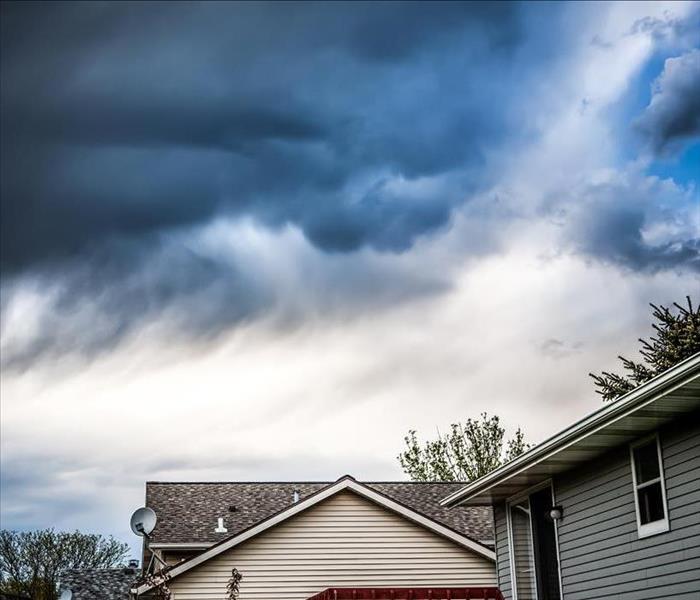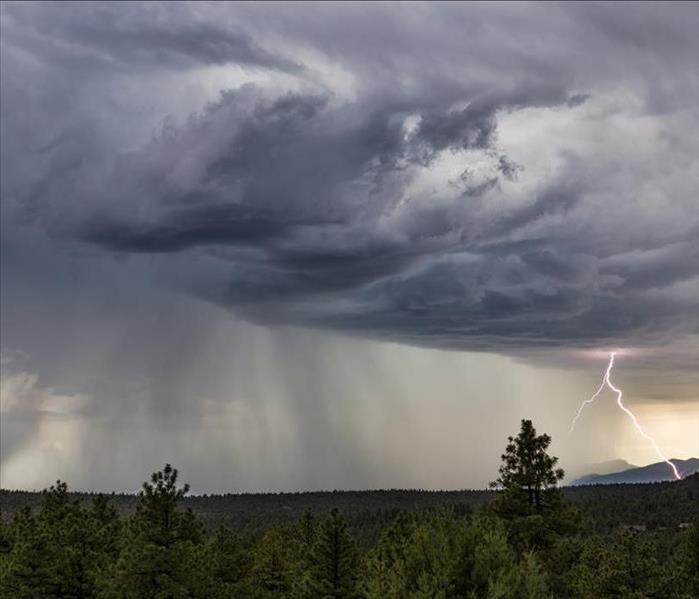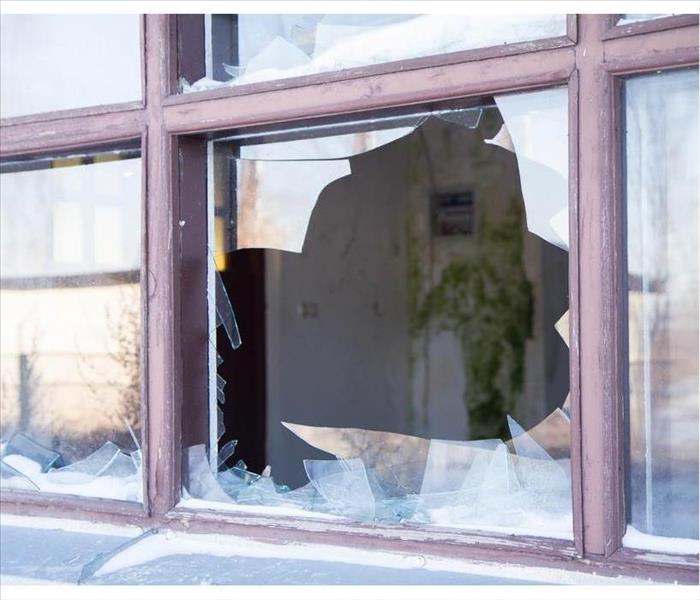Recent Storm Damage Posts
Windows in the Storm: Safeguarding Your Home Against Wind and Debris
12/12/2023 (Permalink)
As the wind howls and debris dances through the air during a storm, your windows stand as the first line of defense for your home. Proper preparation is essential to protect against the potential damage caused by high winds and flying debris. In this blog, we'll explore effective strategies to fortify your windows and ensure your home remains a safe haven during stormy weather.
Install Storm Shutters
Storm shutters are a robust and effective solution for protecting windows during storms. They act as a physical barrier against wind and debris, preventing them from making direct contact with your windows. Choose from various types, including accordion, roll-down, or panel-style shutters based on your preferences and budget.
In the absence of storm shutters, plywood is a cost-effective alternative for window protection. Pre-cut plywood panels can be installed quickly over windows when a storm is imminent. Ensure the plywood covers the entire window, extending beyond the frame, and use appropriate fasteners to secure it in place.
Impact-Resistant Windows
Investing in impact-resistant windows can provide long-term protection against wind and debris. These windows are constructed with laminated glass or a combination of laminated glass and impact-resistant film, making them more resistant to shattering upon impact.
Window film, also known as safety film or security film, can be applied to existing windows to reinforce them against impact. This transparent film adds an extra layer of protection, holding shattered glass together and preventing it from scattering in case of breakage.
Install Storm Windows
Storm windows are designed to offer an additional layer of insulation and protection against the elements. While they may not be as robust as shutters, they can still provide a barrier against wind and debris, helping to minimize the risk of window damage.
Protective screens made from materials like steel or aluminum mesh can be installed over windows to shield against flying debris. These screens are especially effective in coastal areas prone to high winds and hurricanes.
Trim Trees and Branches
Before storm season arrives, ensure that nearby trees and branches are trimmed and pruned. This minimizes the risk of branches breaking off and crashing into windows during strong winds. Regular tree maintenance is an essential preventive measure.
When replacing windows, opt for models specifically designed to withstand high winds and impact. Additionally, choose sturdy window frames, such as those made of aluminum or vinyl, to enhance overall resilience.
Consider Hurricane Film
Hurricane film, a type of window film specifically designed for high-wind situations, provides an extra layer of protection against strong winds and debris impact. It adheres directly to the glass, reinforcing the window's structural integrity.
As a proactive measure, secure outdoor furniture, gardening tools, and other potential projectiles. These items, if picked up by strong winds, can become projectiles that may damage windows and other parts of your home. Just like windows, garage doors are vulnerable to high winds and flying debris. Strengthen them by installing a garage door bracing kit or reinforcing existing doors to minimize the risk of damage.
Create a Home Emergency Kit
In addition to fortifying your windows, ensure you have a home emergency kit prepared. This should include essential items such as flashlights, batteries, a first aid kit, blankets, and non-perishable food and water.
Regularly monitor weather forecasts and stay informed about potential storms in your area. Being aware of approaching severe weather allows you to take timely action to protect your windows and secure your home.
Seek Professional Advice
If you're unsure about the best approach to protect your windows, consult with a professional. Window and home improvement experts can assess your specific situation and recommend the most suitable measures for your home.
Protecting your windows from wind and debris during a storm is a crucial aspect of ensuring your home's safety and resilience. By employing a combination of protective measures, you can fortify your windows against the elements, providing peace of mind and security for you and your family during stormy weather.
How to Protect Windows from Wind and Debris During Storms
9/17/2023 (Permalink)
 As a homeowner or property owner, protecting your windows during storms is essential.
As a homeowner or property owner, protecting your windows during storms is essential.
As a homeowner or property owner, safeguarding your windows during storms is essential to protect your property and ensure the safety of your loved ones. High winds and flying debris pose a significant threat to windows, leaving your home vulnerable to damage. In this blog, we'll explore practical and effective methods to secure your windows and fortify them against the forces of nature during storms.
Reinforce with Storm Shutters
Storm shutters are a highly effective way to shield your windows from wind and flying debris. These durable and impact-resistant shutters act as a barrier, preventing strong winds from exerting excessive pressure on the glass. There are various types of storm shutters available, including roll-down, accordion, and panel-style shutters, offering flexibility and convenience in their operation.
Install Impact-Resistant Windows
Investing in impact-resistant windows can provide long-term protection for your home. These windows are designed with multiple layers of glass and a shatter-resistant interlayer, making them highly resistant to impacts from debris and high winds. Impact-resistant windows not only safeguard your property during storms but also offer added security and energy efficiency benefits.
Use Plywood or Board-Up
In situations where storm shutters or impact-resistant windows are not available, using plywood or board-up is a temporary yet effective solution. Before the storm arrives, cut plywood or acquire precut boards to fit your window openings. Secure the plywood or boards over the windows using appropriate screws or nails. While this method may not be as convenient as permanent solutions, it provides a valuable layer of protection during emergencies.
Install Window Film
Window film can be applied to existing windows as an additional measure to reinforce them against wind and debris. Security window film is designed to hold shattered glass together, reducing the risk of glass fragments flying into your home during a storm. While window film does not provide the same level of protection as storm shutters or impact-resistant windows, it offers a cost-effective option to enhance window safety.
Trim Surrounding Trees and Branches
Before the storm season, ensure trees and branches surrounding your home are well-trimmed. Overhanging branches can become dangerous projectiles during strong winds, causing significant damage to windows and other parts of your property. Regularly prune trees to reduce the risk of branches hitting your windows during storms.
Secure Outdoor Objects
Secure or relocate outdoor objects, such as patio furniture, potted plants, and lawn decorations, before a storm hits. These items can become dangerous projectiles during high winds, potentially causing severe damage to your windows and property. Storing outdoor objects in a safe location or anchoring them securely can prevent them from being blown into your windows.
Protecting your windows from wind and debris during storms is crucial to safeguarding your property and ensuring the safety of your loved ones. Consider investing in storm shutters or impact-resistant windows for long-term protection. In the absence of these options, temporary solutions like plywood or board-up can provide valuable protection during emergencies. Additionally, window film and regular tree trimming contribute to fortifying your windows against storm-related hazards. By taking proactive measures and securing your windows, you can face storms with confidence and minimize potential damage to your home and property.
7 Essential Storm Preparation Tips to Protect Your Home and Family
6/14/2023 (Permalink)
 By following these five storm preparation tips, you can help protect your home and family during severe weather.
By following these five storm preparation tips, you can help protect your home and family during severe weather.
As a disaster restoration company, we understand the importance of being prepared for storms. From hurricanes to tornadoes, storms can cause significant damage to your property and put your family's safety at risk. In this blog post, we will provide you with seven storm preparation tips that can help you protect your home and loved ones.
Create a Disaster Preparedness Plan
The first step in preparing for a storm is to create a disaster preparedness plan. This plan should include information about evacuation routes, emergency contacts, and supplies you will need in case of an emergency. Make sure everyone in your household knows the plan and where to find important documents and supplies.
Secure Loose Items
High winds can turn loose items into dangerous projectiles. Therefore, it is crucial to secure any outdoor items that could become a hazard during a storm. This includes lawn furniture, potted plants, and grills. Move these items inside or anchor them down to prevent them from being blown away.
Trim Trees and Shrubs
Trimming trees and shrubs can help prevent damage to your home during a storm. Remove any dead or weak branches that could fall on your home or power lines. It's also a good idea to remove any trees or shrubs that are too close to your home.
Check Your Gutters
Your gutters play an essential role in protecting your home from water damage during a storm. Clean them out regularly to prevent debris from blocking the flow of water. If your gutters are old or damaged, replace them to ensure they function correctly.
Have a Backup Generator
Power outages are common during storms, so it's a good idea to have a backup generator on hand. A generator can help you keep essential appliances running, such as your refrigerator, medical equipment, and communication devices. Make sure to test your generator regularly and keep it fueled.
Stock Up on Emergency Supplies
It's crucial to have enough emergency supplies to last you and your family for at least three days in case of a storm. These supplies should include non-perishable food, bottled water, flashlights, batteries, a first aid kit, and any necessary medications. Keep these supplies in a designated location and make sure everyone in your household knows where to find them.
Protect Your Windows
During a storm, your windows can be vulnerable to high winds and flying debris. Installing storm shutters or boarding up your windows can help protect them from damage. If you don't have shutters, you can also cover your windows with plywood or use protective film to help prevent shattered glass.
By following these five storm preparation tips, you can help protect your home and family during severe weather. For more information on storm preparedness or if you need assistance with storm damage restoration, contact our team at SERVPRO of Lewisburg/Selinsgrove.
What Are the Most Vulnerable Areas of Your Home During a Storm
1/10/2023 (Permalink)
 During a storm, wind can blow and break your windows leading to water damage.
During a storm, wind can blow and break your windows leading to water damage.
The best way to protect your home from a storm is to know what areas are most vulnerable to damage. This will help you identify if you need to make any repairs or if there are any safety concerns. You may think that the most important places to focus on would be doors and windows, but these aren't always the most at-risk spots of your house when it comes to storms. Here are some other parts of your home that might need extra attention during bad weather.
Doors
Things like doors are the first line of defense against damage to your home. That’s why it’s so important that they be strong enough to withstand wind, rain, and debris. If a door isn’t properly fortified, it can spell disaster for you and your family during a storm.
Windows
Windows are one of the most vulnerable areas of your home during a storm. Wind can blow through windows, breaking them and leading to water damage. Flying debris can also break or crack windows by hitting them at high speed. Wind pressure during a hurricane or strong thunderstorm may even be enough to shatter glass, which makes it even more important to protect your windows with shutters or plywood if you live in an area prone to these kinds of storms.
Roof
The roof is the most vulnerable part of your home during a storm. When the wind and rain come in full force, the roof can be seriously damaged. If that happens, it will no longer be able to withstand the weather as well as it used to. As a result, water damage can occur inside of your home or on other parts of your property.
Another reason why roofs are so important to protect during storms is because they protect all the other aspects of your house from water damage (like walls). If water gets into these areas after being absorbed by shingles or tar paper on top of them then you could end up with mold growth before long!
Siding
Siding is the outer covering of your house, which protects it from weather and insects. It can be made from wood, vinyl, stone, or brick. Siding protects the walls of your home by keeping out moisture and providing a barrier against pests like termites.
If you have siding on your house that's damaged by high winds or hail during a storm, contact an experienced contractor to repair it as soon as possible before water damage sets in or mold starts to grow inside of the walls.
Making sure you have the right storm protection system for your home can help to protect it from all kinds of natural disasters. You can find out more about what types of systems are available and what their benefits are at our website or give us a call today!
2002 Hurricane Season Information
4/11/2022 (Permalink)
See These Safety Tips From Weather.gov
"Hurricanes are among nature's most powerful and destructive phenomena. On average, 12 tropical storms, 6 of which become hurricanes form over the Atlantic Ocean, Caribbean Sea, or Gulf of Mexico during the hurricane season which runs from June 1 to November 30 each year.
While hurricanes pose the greatest threat to life and property, tropical storms and depression also can be devastating. The primary hazards from tropical cyclones (which include tropical depressions, tropical storms, and hurricanes) are storm surge flooding, inland flooding from heavy rains, destructive winds, tornadoes, and high surf and rip currents.
- Storm surge is the abnormal rise of water generated by a storm's winds. This hazard is historically the leading cause of hurricane related deaths in the United States. Storm surge and large battering waves can result in large loss of life and cause massive destruction along the coast.
- Storm surge can travel several miles inland, especially along bays, rivers, and estuaries.
- Flooding from heavy rains is the second leading cause of fatalities from landfalling tropical cyclones. Widespread torrential rains associated with these storms often cause flooding hundreds of miles inland. This flooding can persist for several days after a storm has dissipated.
- Winds from a hurricane can destroy buildings and manufactured homes. Signs, roofing material, and other items left outside can become flying missiles during hurricanes.
- Tornadoes can accompany landfalling tropical cyclones. These tornadoes typically occur in rain bands well away from the center of the storm.
- Dangerous waves produced by a tropical cyclone's strong winds can pose a significant hazard to coastal residents and mariners. These waves can cause deadly rip currents, significant beach erosion, and damage to structures along the coastline, even when the storm is more than a 1,000 miles offshore."
See more:weather.gov
Solar Panel Storm Damage Information
4/10/2022 (Permalink)
Lewisburg, Selinsgrove, and surrounding areas experience all kinds of different storms throughout the year. Many of these storms cause little concern and do little damage to your home. However, high winds, rain, and other conditions may be a concern to the owner of solar panels.
Hail Stones
Hail storms may not be common in your area, but they can create various problems for property owners. You may wonder about panel damage if hail starts falling, but you can have peace of mind knowing that these panels should not be affected.
The panels are made of tempered glass and highly flexible material, and are built to withstand impact from rock, hail or other materials.
Wind
While high winds can cause roof damage, they are much less likely to cause panel damage. Your solar panels are designed to withstand up to 140-mph winds. This means they can hold up against hurricanes and other less potent storms.
Snow and Rain
If you purchase a high-quality set of panels, they should last 25 years or more. They are well-equipped to handle a rainstorm or a snowstorm. The glass portion of the panels has protection from any negative effects from precipitation.





 24/7 Emergency Service
24/7 Emergency Service


